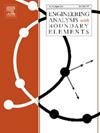多个表面穿孔垂直薄壁屏障对浮动刚性船坞的波浪衰减作用
IF 4.2
2区 工程技术
Q1 ENGINEERING, MULTIDISCIPLINARY
Engineering Analysis with Boundary Elements
Pub Date : 2024-10-14
DOI:10.1016/j.enganabound.2024.105985
引用次数: 0
摘要
根据有限水深线性化势流假设,探讨了重力波与多个表面穿透薄多孔壁垒阵列相互作用的散射问题。假定屏障之间的距离有限,且位于码头的靠岸一侧。此外,还假设穿过多孔屏障的波浪遵循达西定律。研究了波浪的特性,如反射系数和透射系数、波能耗散以及浮动硬质码头上的水平波力,以检验不同数量的屏障和屏障长度(H)、屏障的孔隙率、屏障之间的间距以及最后一个屏障与浮动硬质码头之间的距离的有效性。结果表明,更多的表面穿孔屏障明显有助于缓解波浪与浮动刚性码头相互作用时产生的力。我们注意到,设置四个穿孔屏障不仅能减少约 70% 的反射,还能增强 90% 的波浪能量消散,而屏障长度大小相等的效果最好。与刚性屏障相比,多孔屏障更有利于减轻波力。此外,当屏障长度设定为 H/h=0.7,孔隙率设定为 1.212(h 为水深)时,可以观察到零反射。另一方面,当屏障长度为 H/h=0.6 时,反射的临界入射角为 31.81°。此外,结构间归一化间距的扩大有助于波浪的反射和传输,以及波浪能量的消散,从而显示出周期性模式。自由表面高程图无疑有助于加强将多重屏障作为减轻浮动码头上波浪力的工具的说法。本文章由计算机程序翻译,如有差异,请以英文原文为准。
Wave attenuation on a floating rigid dock by multiple surface-piercing vertical thin perforated barriers
The scattering of gravity waves interacting with an array of multiple surface-piercing thin porous barriers is explored based on the hypothesis of linearized potential flow for finite water depth. The barriers are assumed to be stationed at a finite distance from each other and on the lee side of the dock. Also, it is hypothesized that the waves passing through the porous barriers follow Darcy’s law. The wave properties such as reflection and transmission coefficients, dissipation of wave energy, and horizontal wave force on the floating rigid dock are studied to check the effectiveness of different numbers of barriers and length () of barriers, their porosity, the spacing between barriers, and the distance between the last barrier and the floating rigid dock. It has been witnessed that more surface piercing barriers are obviously helpful in relieving the force due to the wave interaction with the floating rigid dock. It is noticed that implementing four perforated barriers not only reduces reflection by around 70% but also enhances wave energy dissipation by 90%, with equal size of barrier lengths being the most effective. The porous barriers are more conducive to alleviating the wave force than the rigid barriers. Additionally, it is observed that there is zero reflection when the barriers’ length is set at and set porosity at 1.212 (where is the water depth). On the other hand, the critical incidence angle for reflection is also noticed with barriers of length . Further, the expansion of the normalized spacing between the structures helps reflect and transmit the waves along with the dissipation of wave energy to display a periodic pattern. The free surface elevation plots certainly help to fortify the claim of having multiple barriers as a tool to mitigate the wave force on the floating dock.
求助全文
通过发布文献求助,成功后即可免费获取论文全文。
去求助
来源期刊

Engineering Analysis with Boundary Elements
工程技术-工程:综合
CiteScore
5.50
自引率
18.20%
发文量
368
审稿时长
56 days
期刊介绍:
This journal is specifically dedicated to the dissemination of the latest developments of new engineering analysis techniques using boundary elements and other mesh reduction methods.
Boundary element (BEM) and mesh reduction methods (MRM) are very active areas of research with the techniques being applied to solve increasingly complex problems. The journal stresses the importance of these applications as well as their computational aspects, reliability and robustness.
The main criteria for publication will be the originality of the work being reported, its potential usefulness and applications of the methods to new fields.
In addition to regular issues, the journal publishes a series of special issues dealing with specific areas of current research.
The journal has, for many years, provided a channel of communication between academics and industrial researchers working in mesh reduction methods
Fields Covered:
• Boundary Element Methods (BEM)
• Mesh Reduction Methods (MRM)
• Meshless Methods
• Integral Equations
• Applications of BEM/MRM in Engineering
• Numerical Methods related to BEM/MRM
• Computational Techniques
• Combination of Different Methods
• Advanced Formulations.
 求助内容:
求助内容: 应助结果提醒方式:
应助结果提醒方式:


